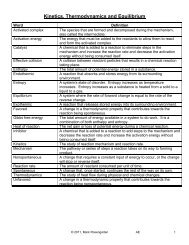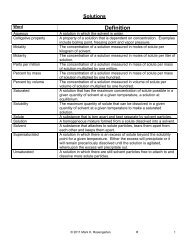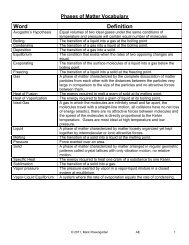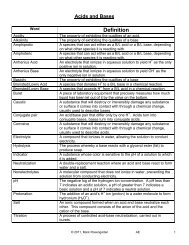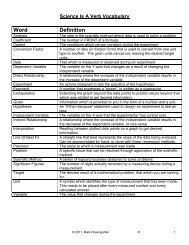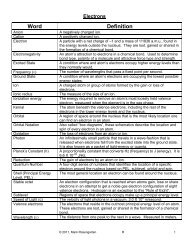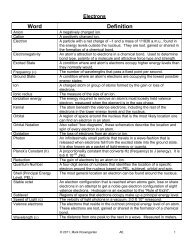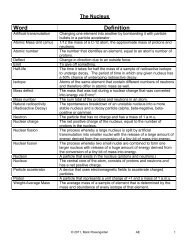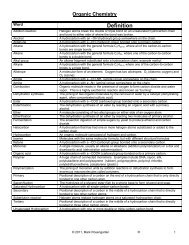Unit 4 - Mark Rosengarten
Unit 4 - Mark Rosengarten
Unit 4 - Mark Rosengarten
You also want an ePaper? Increase the reach of your titles
YUMPU automatically turns print PDFs into web optimized ePapers that Google loves.
4) Nuclear Power (HW: p. 26, 27)<br />
Essential Question: How can we turn one element into another and get a lot of useful energy in the process?<br />
1) Artificial Transmutation: Changing one element into another one<br />
The Sun contains 92 naturally occurring elements, from hydrogen to uranium. All of the elements more massive than<br />
uranium were produced using artificial transmutation. From Neptunium (93) to Ununoctium (118), these<br />
“transuranium” elements were made by people!<br />
So, how can you make an element? You need three ingredients:<br />
1) A sample of target nuclei, usually very heavy ones.<br />
2) A particle “bullet” that has a charge (almost always a positive charge, like an alpha particle or another nucleus, but<br />
electrons can be accelerated, too)<br />
3) A particle accelerator to make the bullet move fast enough (close to the speed of light) to collide with the nuclei<br />
and change them into different elements.<br />
The particle accelerator uses electromagnetic fields to accelerate charged particles. Neutral particles, such as<br />
neutrons or gamma rays, cannot be accelerated in a particle accelerator.<br />
Particle accelerators need to be HUGE in order to get the bullet particles up to speed. Here is a list of a few currently<br />
operating particle accelerators and their sizes:<br />
1) U.C. Berkeley Cyclotron: round, 60 inches in diameter. Element 97, Berkelium (Bk) is named in honor of this place<br />
where so many new isotopes were made.<br />
2) LEP at CERN, ring-shaped, 27 kilometers (17 miles) in diameter. CERN is located northwest of Geneva,<br />
Switzerland, on the French/ Swiss border.<br />
3) Large Hadron Collider at CERN, multiple-rings, 27 kilometers (17 miles) in diameter.<br />
Generally, the larger the collider, the faster the particle bullets can travel, so heavier and heavier elements can be<br />
made.<br />
To determine the products of artificial transmutation:<br />
Step 1: One of the products will be unknown. Add up the mass numbers on the side that all particles are known. The<br />
mass numbers of the other side should add up to the same thing.<br />
Step 2: Add up the atomic numbers (charges) on the side where all particles are known, The charges of the other<br />
side should add up to the same thing.<br />
Step 3: Look up the atomic number (if 3 or more) on the Periodic Table and identify what element you have. If the<br />
atomic number is 2 or less (including -1), then look up the identity of the particle on Reference Table O.<br />
14<br />
7 N + 4 2He 17 8O + X On the top: 14 + 4 = 17 + x, so the mass is 1. X is 1 1 H<br />
On the bottom: 7 + 2 = 8 + x, so the charge is 1.<br />
This is a PROTON, according to Reference Table O.<br />
27<br />
13 Al + 4 2He ---> X + 1 0n On the top: 27 + 4 = x + 1, so the mass is 30. X is 30 15P<br />
On the bottom: 13 + 2 = x + 0, so the charge is 15.<br />
Element 15 is PHOSPHOROUS (P).<br />
© 2011, <strong>Mark</strong> <strong>Rosengarten</strong> R 14



